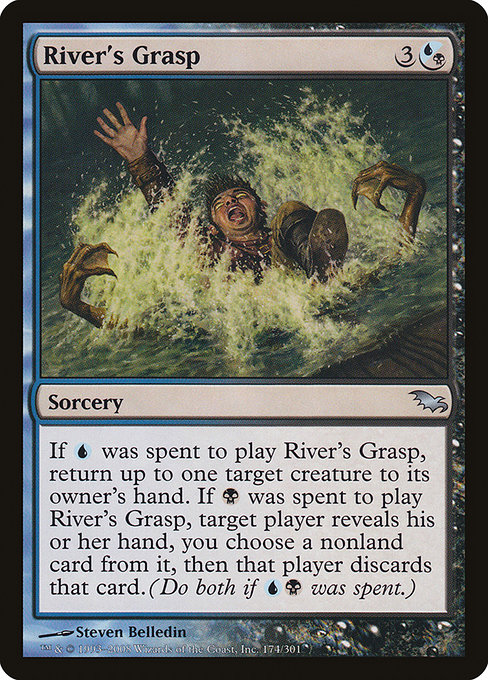
Image courtesy of Scryfall.com
The role of grading companies in card valuation
In Magic: The Gathering, the path from casual play to a serious collectibles market is paved with condition, provenance, and a little bit of mystique. Grading companies—think PSA, BGS, and CGC—have become a visible force in determining card value beyond surface-level rental-costs and playability. They certify a card’s physical state, assigning a numeric grade that speaks to centering, corners, edges, and surface. For many collectors, a mint or near-mint card in a protective slab offers more than comfort; it offers a signal to future buyers that the card has stood up to time, handling, and the occasional misadventure during transport or storage. 🧙♂️🔥
Consider a Shadowmoor-era gem like River’s Grasp, a multicolor sorcery that dances on the edge of disruption and control. With a cost of {3}{U/B}, this spell is deliberately flexible, offering two distinct effects depending on how you pay. If you spearhead casting with {U}, you can bounce a creature. If you pay with {B}, you pry information from your foe—forcing them to reveal their hand and discarding a nonland card you choose. Do both if you mix the colors. In casual and EDH circles, this kind of versatility is valuable, which means condition matters when the card leaves the binder and heads toward a slab. The nonfoil version carries a modest price around USD 0.14 (EUR ~0.06), while foil variants lag behind in availability and premium value. That gap can be meaningful when a card crosses into graded status, where a pristine example could command a premium relative to its raw price. 💎
What grading really tests in MTG cards
Grading isn't just an aesthetic judgment; it's a risk assessment about future liquidity. A sought-after card in high-grade condition reduces the risk that a buyer will discover a flaw after purchase. For a card like River’s Grasp—thematically and strategically interesting but not a flagship rare—the premium attached to a high grade is often smaller than for power-level staples from the same era or from more recent, hotly debated sets. Still, for collectors who want to lock down a complete Shadowmoor run with consistently clean centering and sharp edges, a PSA, BGS, or CGC grade can add measurable appeal. And when a card exists in both nonfoil and foil, the presence of a graded foil—if it exists in a strong grade—can create a noticeable, if modest, uplift in value. 🔥
Grading services weigh several tangible factors. Centering is king; a perfectly centered card in a near-mint condition tends to fare better in a slab than a miscut twin. Edges and corners must resist whitening and chipping; surface should be free of scratches and print defects. ForRiver’s Grasp, a card with minimal handling marks and a clean rainbow of blue-black color in its border and art crop will fare better than one with visible scuffs or edge wear. The resulting grade—9 or 10 on many services—can then unlock a tiered market: raw copies sell to casual players, while graded copies attract collectors and investors who want a boxed-in guarantee of quality. 🎲
How to approach grading with your MTG collection
If you’re contemplating sending cards to a grading service, start with a cost-benefit check. Grading fees, shipping, and potential grading-time delays can add up. For a card with a modest raw value, the total investment might not pencil out even with a high grade, unless you’re aiming for a close-to-perfect run of a specific set. However, for sealed, beloved, or competitively relevant cards—think commanders staples, first-prints, and unique misprints—the math can tilt in favor of grading. Always research current pop reports and price data for the grade you hope to achieve; compare that against the card’s raw price and the typical premium for a given grade. And remember: grading is a market bet as much as a quality control measure. The value can swing with demand, reprints, and shifting formats. ⚔️
River’s Grasp serves as a useful case study in this dynamic. It’s a dual-color spell from Shadowmoor, with a flexible mana cost and dual-mode effect set. While it’s not a marquee rarity, it’s precisely the type of card where a curated, high-grade copy can appeal to EDH enthusiasts who value dual-purpose control and steal-based strategies in their decks. A graded copy, if it exists at a favorable grade, could attract attention in market discussions and auctions, nudging its price slightly higher than the raw metal. Yet the bulk of copies, especially nonfoil prints, will likely stay in affordable territory for most players. The key is balance: weigh the joy of owning a pristine graded card against the upfront costs and the ever-shifting collector market. 🧙♂️🎨
“Grading is not a crystal ball, but a well-lit snapshot. It helps buyers and sellers align expectations and reduces friction in long-term trades.”
For enthusiasts who want to explore the broader landscape, remember that grading interacts with a card’s accessibility across formats. In Modern and Legacy, River’s Grasp is not legal in Standard, but in Vintage and certain casual formats, its two-pronged utility can shine. The rarity, color identity, and the purely nostalgic aura of Shadowmoor-era cards add to the allure, even when the market shows modest price signals. Grading doesn’t create value from nothing; it amplifies perceived quality and confidence, which can translate into a tangible premium when the stars align. ⚡
Custom Mouse Pad Round or Rectangle Neoprene Non-Slip Desk PadMore from our network
- https://blog.zero-static.xyz/blog/post/parody-in-magic-the-gathering-shaping-fan-identity-through-secret-door/
- https://blog.digital-vault.xyz/blog/post/mythic-currents-exploring-into-the-roil-in-mtg-lore/
- https://crypto-acolytes.xyz/blog/post/shaping-the-future-of-ai-governance-in-web3/
- https://blog.digital-vault.xyz/blog/post/navigating-routes-and-biomes-in-tatsugiri-droopy-tips/
- https://blog.digital-vault.xyz/blog/post/faint-parallaxes-reveal-galactic-halo-members-and-a-hot-blue-star/